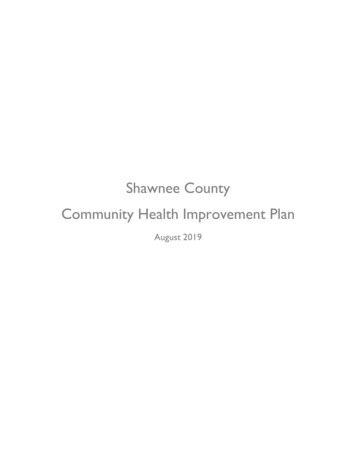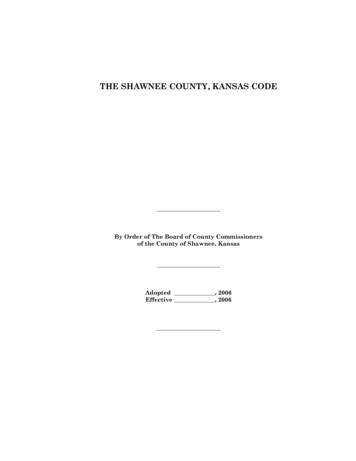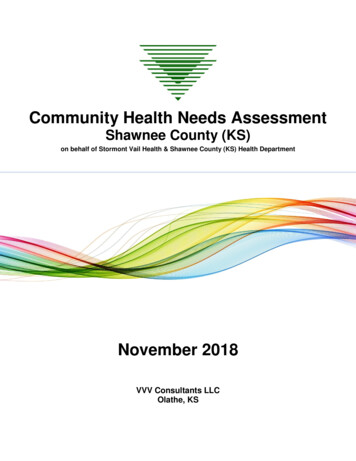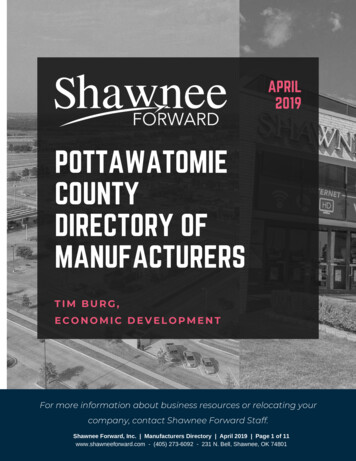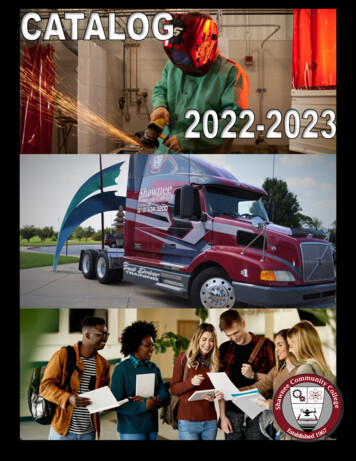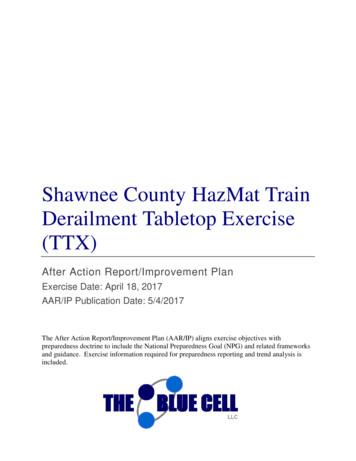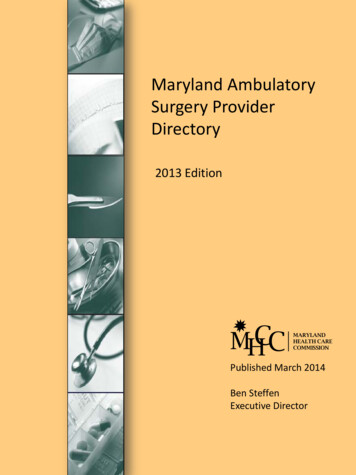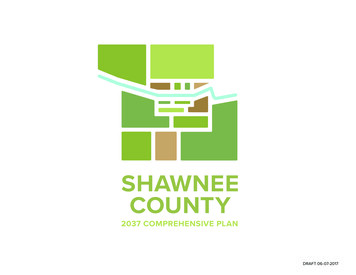
Transcription
SHAWNEECOUNTY2037 COMPREHENSIVE PLANDRAFT 06-07-2017
TABLE OF CONTENTSINTRODUCTION.3CHAPTER 1Population and Demographics.13CHAPTER 2Natural and Cultural Resources.23CHAPTER 3Transportation, Utilities, and Public Services. 41CHAPTER 4Land Use and Design.79CHAPTER 5Housing and Neighborhoods.103CHAPTER 6Economic Development. 123CHAPTER 7Implementation. 143APPENDIX. XDRAFT 06-07-2017
4
SHAWNEE COUNTY 2037 COMPREHENSIVE PLANACKNOWLEDGEMENTS-5DRAFT 06-07-2017
TABLE OF FIGURES6
SHAWNEE COUNTY 2037 COMPREHENSIVE PLAN7DRAFT 06-07-2017
8
SHAWNEE COUNTY 2037 COMPREHENSIVE PLANFORWARD & VISIONSTATEMENTForwardEach of us is connected to the shared history ofShawnee County and the stories we bring to it. Weare committed to working together to forge a sharedfuture, aware of our connections to each other andrespectful of our differences. We are connected tothe five cities and the many unincorporated townsin Shawnee County. We are connected to the rurallandscapes and the farms and ranches in ShawneeCounty. These are the places that help define whowe are as Shawnee Countians. We take pride in ourschools. Our parks are among the best in Kansas.Vision StatementA vision statement describes a community’s valuesand aspirations and a shared image of what they wanttheir community to become over the next 10 to 20years in the future. The statement should address allaspects that make up a community such as the social,cultural and economic fabric. Statements should beforward thinking and written in a positive, affirmativeand inspirational style. The vision statement functionslike a captain steers a ship to stay the course on itsjourney as changes occur.Vision StatementThe Shawnee County Comprehensive Plan willenhance the quality of life for county residents by: Preserving the rural character of the county Protecting natural, scenic and historicresources Protecting agricultural lands and agriculturaloperations Promoting responsible growth anddevelopment Promoting economic development andtourism opportunities Enhancing cooperation between all levels ofgovernmentWe recognize that the future of Shawnee County isconnected to the natural resources and systems wedepend on and enjoy. We understand the local andregional economic relationships that have developedover time and connect us to each other. We envision afuture in which our fiscal and environmental health arein balance and we are wise stewards of the future.Although this plan consists of multiple chapters, it isa single document, representing a coherent visionfor Shawnee County’s future. Looking forward, weknow that Shawnee County will continue to change,and change will present both opportunities andchallenges. We have tried to foresee and account forthese changes, knowing that Shawnee County willalso face situations we could not predict when thisplan was written. To help guide us through the future– both known and uncertain – we have tried to createa plan that calls attention to parallels as well as thepotential conflicts and trade-offs in the choices that lieahead.1DRAFT 06-07-2017
INTRODUCTIONDRAFT 06-07-2017
INTRODUCTIONShawnee County, capitol county of Kansas, is the thirdmost populous county in the state with a populationapproaching 178,000. Overall, the county has grownover the past fifty years, driven by the county’s strongeconomic base.Comprised of 556 square miles, the Shawnee Countycontains five incorporated communities includingTopeka, its largest city and the State Capitol, andthe four smaller cities of Auburn, Rossville, SilverLake, and Willard. Beyond those, the county hasmore than 40 other taxing jurisdictions which makepublic expenditures for public services, including 12townships, school districts, rural water districts, firedistricts, drainage districts, and others.As of 2010, 46,552 residents lived outside thecounty’s five cities, about three and a half timeshigher than would be expected compared toDouglas, Johnson, Riley, and Sedgwick Counties. Forcontext, the tenth largest city in Kansas, Salina, hasa population of 47,707. Most of these residents arenot actively engaged in agriculture, which creates apotential for conflicts between residents and activefarming and mining operations near them. These arisefrom differing expectations regarding the use andmaintenance of property and the types, amount, andcosts of public services.Property-owners and developers are becomeconfused about development near the City of Topeka.The City exercises authority under Kansas Statutes toapprove plats and land subdivision within its 3-mileExtra Territorial Jurisdiction (ETJ), but ShawneeCounty retains other development approval authority.Topeka’s Land Use & Growth Management Planestablishes development tiers outside city limits todirect future growth, including where city utilities areextended and what areas may be annexed. Topeka’splan encourages much of the land within the ETJ toremain rural or develop at very low densities, a markeddeparture from past trends.Rural Shawnee County’s abundant natural resourcescan also be impacted by continued growth anddevelopment in profound and often unanticipatedways. The county is currently considering the value ofpreserving prime farmland, how best to permit mineralextraction in the county, and the value of naturallandscapes like the Osage Cuestas, Glacial Hills, andFlint Hills and features like the Kansas and WakarusaRivers which can be used for tourism and recreation.These factors prompted the county to begin its firstcomprehensive planning process. Communities,like businesses, must analyze their settings andopportunities, choose directions, and use theseto their greatest advantage. A plan provides aroadmap intended to guide the continued growth anddevelopment of the county over the next 20 years,through 2037. It establishes a compelling vision ofwhat the community of Shawnee County wants to lookand feel like in the future, derived from the aspirationsof its citizens. To reach that vision, it identifies thenecessary steps and recommends priorities andpolicies. The comprehensive plan can help strikethe right balance between many of the issues thatShawnee County is currently experiencing.As a policy document, the comprehensive plan isintended to guide decisions concerning growthand development in the county. It may recommendchanges to land use or division regulations but doesnot create new regulations. Preparing, adopting, andimplementing a comprehensive plan is a chance forthe county to discuss its future, identify priorities, andfind actions to reach the community’s desired vision.4To that end, this comprehensive plan as the first forunincorporated Shawnee County will help definethe character of the county and recommend policiesbased on this character and the priorities of itsresidents over the next 20 years. The document willbe produced to be implemented and utilized by thecounty and its policy makers while managing futuredemographic, economic, and environmental change.COMPREHENSIVE PLANSPERFORM THREECRITICAL FUNCTIONS:1. PRACTICAL: ESTABLISHES A LEGAL BASIS FORREGULATING LAND SUBDIVISION & USE.2. ASPIRATIONAL: CLARIFIES WHAT RESIDENTSAND COUNTY LEADERS WANT FOR THEFUTURE OF THE COUNTY.3. INSPIRATIONAL: DETERMINES HOW LANDUSE, ECONOMIC DEVELOPMENT, NATURALRESOURCES, TRANSPORTATION, ANDINFRASTRUCTURE DECISIONS WORKTOGETHER TO CREATE THE FUTURE.
SHAWNEE COUNTY 2037 COMPREHENSIVE PLANWHY PLAN?Shawnee County has never prepared a comprehensiveplan, despite its significant role in the State andmultiple overlapping taxing jurisdictions. Planning canimprove coordination and collaboration between localgovernments by providing a unified vision, identifyingareas where the county expects to grow, and openingthe door to further discussion. In places like Douglas,Johnson, Riley, and Sedgwick Counties, comprehensiveplans led to several benefits. Riley County’s plan helpedidentify policies to protect farmers and ranchers, whileproviding for growth in areas that made sense for ruraltaxpayers. Johnson County’s planning process broughttogether residents, businesses, institutions, and specialinterests to create a vision for the region’s future and tohelp elected officials make decisions.These illustrate how the comprehensive planningprocess for Shawnee County provides an opportunityto evaluate its current position, think ahead, andmanage development according to a unified andcompelling vision derived from the aspirations of itscitizens. The plan also defines specific actions thatcan help fulfill that vision which allows the Countyto develop by design rather than default. ShawneeCounty’s comprehensive plan will also fulfill threefundamental roles:PracticalCommunities prepare and adopt comprehensiveplans for practical legal purposes. Kansas StateStatute 12-741 gives counties the ability to adoptzoning and subdivision regulations to promote thehealth, safety, and welfare of its citizens. Zoningordinances recognize that people in a communitylive cooperatively and have responsibilities to oneanother. Other land use regulations, such as those forsubdivisions, are based on the premise that growthshould comply with specific standards and occur inan economically efficient, coordinated manner. Theseordinances help determine to develop land.However, land use decisions need to follow anaccepted and reasonable idea of how the countyshould grow. Therefore, Kansas state law requiresthe adoption of a comprehensive plan to implementthese regulations. Statute 12-747 requires a plan toreview past and present conditions and trends. A planmust at least address and make recommendations fordevelopment or redevelopment including: Land use or the planned distribution of activitiesand uses of land; Population and building intensity standards andrestrictions and the application of the same; Public facilities and improvement programmingand prioritization; Utilization and conservation of natural resources;and Economic conditions, major sources andexpenditures of public revenue, and financialstrategy.InspirationalIn addition to its practical and aspirational roles, theplan serves an inspirational role to guide City staff,the Planning & Zoning Commission, the CountyCommission, and other City boards and commissionsas they set policy and make land use decisions.The plan contains useful background information toconsider for the county’s future and assists countyofficials with policy discussions with non-countygroups. The plan also guides other taxing jurisdictionssuch as school districts and rural water districts inmaking public investments in facilities like county roadsand can lay the foundation for decisions about thetypes of services that the residents of rural ShawneeCounty want. Doing so helps other jurisdictions alsomake wise public investments by informing them ofwhere growth is anticipated and development mayoccur. This can reduce the cost of public service andlimited availability of desired public services.AspirationalA land use plan that provides a basis for zoning andsubdivision regulations helps communities developefficiently and responsibly. Yet, the greatest valueof a comprehensive plan is for Shawnee County tocreate a detailed concept for the community’s future,based on the participation of residents in the planningprocess. This concept addresses both demographicand economic changes and opportunities. This givesresidents a voice in the future of their community whileproviding more certainty to property-owners abouthow land can be used and what public services arelikely to be provided or required. However, the planremains working document that changes accordingto current situations to ensure Shawnee County canrealize its full potential.Caption Here5DRAFT 06-07-2017
PUBLIC INVOLVEMENTThe planning process was conducted by theShawnee County Planning Department and RDGPlanning & Design, in collaboration with CSFEngineers. In June 2016, county commissionersidentified economic development, land use, naturalresources, transportation & infrastructure, andintergovernmental coordination as key priorities forthe plan. However, public participation was a criticalelement in engaging citizens and stakeholders toinform decisions and ensure that the plan outcomesare meaningful, appropriate, and achievable. Keepingofficials, agencies, local governments, the public,and interested parties informed of the planning effortfurther promoted opportunities for input into the plan.The public was engaged through the following steps:Steering CommitteeA 22-member Comprehensive Plan SteeringCommittee, representing a broad spectrum ofcommunity interests was convened to offer primaryguidance to the plan. Committee members metmonthly to assist in identifying emerging issues,refining vision statements and objectives, andprioritizing the community’s goals. As the plandeveloped, they also reviewed it through thedevelopment process.Community QuestionnaireTo begin the planning process, a communityquestionnaire was made available to all interestedresidents and stakeholders. The questionnairefocused on the relative importance of variouscommunity services and facilities. Over 320 responseswere received. These responses helped frame theimportant issues and goals as seen through the eyesof the community and were used to set the agendafor focus group meetings and the visioning processundertaken by the Steering Committee.Stakeholder GroupsTargeted stakeholder group meetings were held overtwo days in September 2016. In total, 62 residents,business and property owners, employers, and publicofficials participated in round-table discussions onseveral issues. These discussions provided a forum forcommunity members and representatives to expandand refine the information from the questionnaire andto have in-depth discussion of their broader opinionsof the community and its future. Additional meetingswere held with representatives from the Cities ofAuburn, Silver Lake, Rossville, and Willard and theCitizen Band of the Pottawatomie Tribe in October andNovember.Public Open HousesTwo public open houses were held the evenings ofOctober 27, 2016 and November 1, 2016 at Seamanand Washburn Rural High Schools. The generalcommunity was invited to share their ideas forShawnee County and work alongside the planningteam to help create the comprehensive plan. Theformat began with a brief presentation introducingattendees to the planning process, followed by anopen house. Attendees investigated boards withinformation collected thus far and shared theirideas, issues, and concerns with the planning teamfor incorporation into the development of the plandocument. 36 people participated in these events with9 at the first meeting and 27 at the second, excludingthe planning team.6
SHAWNEE COUNTY 2037 COMPREHENSIVE PLANPublic Design WorkshopsProject WebsiteTwo public design workshops were held the eveningsof February 1, 2017 and February 2, 2017 at WashburnRural High School and Northern Hills ElementarySchool. Using projections of residential, commercial,and industrial growth through 2040 and accounting forresidents’ goals and objectives, the team shared futurescenarios. About 30 members of the public attendedand helped fine-tune these ideas, in addition to sharingtheir own. It also provided an opportunity for the publicto think critically about how Shawnee County maylook in the future and add their voices to the plan. Thefuture land use map was especially shaped by theseworkshops, in addition to area concepts.A project website was created and routinely updatedwith new information on the project as it evolved. Thisserved as a resource through which interested citizenscould stay involved and engaged with the project.Documents, including the Big Ideas summaries,were also posted to the website in addition to thecompleted plan.Big Ideas SeriesTo actively involve the public in the processdeveloping the Plan’s, the team produced a series often “Big Ideas” summaries to cover the plan’s majortopics in partnership with the Topeka Capital Journal.Each introduced a topic and explained relevantconsiderations, plan goals, and recommendations.This provided another opportunity to engage andinform as much of the public as possible and providedan opportunity for the public to understand the plan’srecommendations in order to shape them.Commission InvolvementThe planning and county commissions were especiallyinvolved in the planning process. The planningcommission attended the final steering committeemeetings in order to voice their ideas about theplan’s goals and recommendations and also providedcomments about the completed chapters. The countycommission stayed active as the plan was adopted,with a workshop on June 12, a public hearing with theplanning commission on July 10, and a final adoptionhearing held July 24.Final Public Open HouseThe final public open house was held June 15 at theBig Gage Shelter House at Gage Park. This provideda public forum for attendees to come and voice theircomments, questions, and concerns of the plan’sgoals and recommendations. In total, participantsattended.7DRAFT 06-07-2017
ISSUE IDENTIFICATIONFigure 0.1: What do you believe are Shawnee County’s three greatest assets?During the initial stages of the planning process,the county commission, steering committee,questionnaire, stakeholder groups, and public openhouses allowed residents of Shawnee County toexpress their thoughts about the county’s services,facilities, strengths, weak nesses, and future direction.Responses helped measure public perceptions of thecounty and suggested potential future priorities andgeneral actions.Questionnaire ResponsesQuestionnaire respondents identified the following asthe primary perceived strengths of Shawnee County: Schools Location in northeast Kansas Park system Quality of life Property valuesQuestionnaire respondents identified the following asimportant issues facing the county: Ability to retain young peopleSource1: RDG Community Questionnaire Attracting new industries and businesses Public finances and taxes Recruiting higher paying industries Having a vision for the futureThese opportunities and threats reappear throughoutthe plan. Other survey results are included at thebeginning of relevant sections, informing many of thepolicies and discussions.Recurring ThemesSeveral themes emerged during discussion withgroups, including: Natural Resources. Shawnee County contains avariety of environmental resources and features8
SHAWNEE COUNTY 2037 COMPREHENSIVE PLANthat should be recognized and preserved and theland’s carrying capacity should not be exceeded.Figure 0.2: What do you believe are the most important issues facing Shawnee County in the next ten years? Transportation & Infrastructure. The county willstrive to provide services in an efficient andcost-effective manner by encouraging carefuldevelopment and expansion, accounting for futureneeds and desires, and coordinating with relatedgroups and agencies. Land Use & Development. Land use policy shoulddirect urban development to minimize conflictsbetween land uses, take advantage of existinginfrastructure, protect the character of the county,and clarify expectations for development. Economic Development. Planning efforts shouldpromote job creation and opportunities forentrepreneurship, recognize the importance ofagriculture, mineral extraction, and homebasedbusinesses to the vitality of the county’s economy,and provide easy access to commercial areas. Housing. Shawnee County should have a varietyof housing types, existing housing in historicdevelopment areas should be preserved andimproved, and new housing should be provided ina manner consistent with its surroundings. Intergovernmental Cooperation. The county andits townships, utility providers, and other taxingjurisdictions should actively communicationand involve each other and the area’s residentsand businesses to decrease costs and maintainorderly development. Quality of life. Planning should enhance thecounty’s quality of life through well-maintainedinfrastructure, numerous recreational activitiesand facilities, and safety, in addition to increasingresidents pride in the county and its small andunincorporated towns.Source1: RDG Community Questionnaire Avoid burdensome regulation. Planning shouldnot create regulation that would decrease landvalues, provide an undue burden, or does notenhance the public’s health, safety, or welfare.9DRAFT 06-07-2017
APPROACH AND FORMATThe Shawnee County 2037 Comprehensive Planis organized into several chapters. Each topicallyexplores the existing conditions, findings, goals, andrecommendations. The final chapter synthesizes thisinformation to implement the plan and identifies toaccomplish these recommendations. The chapters areorganized as follows:1. DemographicsPres ents a demographic snapshot of the county,analyzing its historic population, comparing it tocomparable communities, reviewing demographicconsiderations, and projecting its potential futuregrowth.2. Natural Resources:Explores Shawnee County’s natural resources,including environmental resources and features thatshould be recognized, preserved, or used such asfloodplains, wetlands, landscapes, farmlands, andcultural or historic resources like the Oregon Trail andNative Stone Scenic Byway, among others.3. Transportation & Infrastructure:Discusses the development and support of an efficientcounty road network to serve future circulation andaccess needs, in addition to the provision of otherservices to residents such as utilities and services likecell phone coverage, schools, internet, and rural waterand sewer.5. Housing:Discusses historical housing development in thecounty, including the affordability of housing inunincorporated areas, homes for families engagedin agriculture, homes on suburban estates, and otherhousing options such as manufactured homes or smallapartments.6. Economic Development:Explains Shawnee County’s current economyand workforce, anticipated industry growth andchange, changes in the nation’s economy, and otherconsiderations for economic development in thecounty including home occupations, agri- and historictourism, and the effects of quality of life.7. Intergovernmental Cooperation:Lays out how Shawnee County can work with themore than 50 taxing jurisdictions to make decisionsaffecting how the county will grow and developover time, including how to assure the best possibleoutcomes for the benefit of the county, its residentsand businesses, and its finances.8. ImplementationSynthesizes information from the previous chaptersand presents how the county can accomplish theserecommendations on a reasonable time schedulegiven the county’s fiscal capacity, current policy, andneed to work with other jurisdictions and its residents.4. Land Use:Identifies land use policies for future growth anddevelopment, including the direction of urban andsuburban development, current policies for land use,and how existing infrastructure and natural resourcesaffect it. It also explores the interaction of land usewith agriculture, and rural lifestyles.10
SHAWNEE COUNTY 2037 COMPREHENSIVE PLANCity of RossvilleCity of SilverLakeCity of WillardCity of TopekaCity of AuburnFIGURE 0.3: Map of Shawnee County11DRAFT 06-07-2017
CHAPTER ONEPopulation andDemographicsShawnee County is one of the largest and most dynamiccounties in Kansas. This chapter presents a demographicsnapshot of the county, analyzing its historic population,comparing it to comparable communities, reviewingdemographic considerations, and projecting its potentialfuture growth.DRAFT 06-07-2017
HISTORIC POPULATION GROWTHFor 50 years, Shawnee County has had steadygrowth, especially in unincorporated areas. Thepopulation of the County grew by 36,600 peoplebetween 1960 and 2010, averaging more than 5percent each decade, despite a decrease in the 1970s.In 2010, the county reached nearly 178,000 residents.Topeka also experienced steady albeit slower growthover that same period.Of the growth occurring in the county, about Topekagrew by 8,000, the county’s small cities grew by2,600, while rural Shawnee County grew by morethan 26,000. Because of the growth in unincorporatedareas, it now comprises over a quarter of the county’s2010 population, compared to comprising less than 15percent in 1960.Of the county’s four smaller cities, most grew.Auburn developed during the 1960’s to more than1,200 people by 2010. Rossville expanded almost 14percent to a population just over 1,100. Silver Lakemore than tripled its population, reaching nearly 1,500residents. However, Willard grew through the 1980’s,but stabilized near its 1960’s population due to homebuy-outs following flooding. In total, these small citiescomprise 2.2 percent of the county’s population.Not all areas of Shawnee County have grown equally.Soldier and Mission Townships grew the most since1960, each by more than 8,000 residents. These arefollowed by Auburn, Monmouth, and Tecumseh withmore than 2,000 new residents each. Soldier, Mission,and Tecumseh all border the City of Topeka.FIGURE 1.1: 1960-2010 Historic City Population1960197019801990200020102000-2010 %CHANGE1960-2010 ille7979341,0451,0521,0141,15113.5%44.4%Silver 23737,63343,91546,5526.0%126.9%Shawnee 7%25.9%Source: US Census BureauFIGURE 1.2: 1960-2010 Historic Township Populations and Topeka (in order of size)1960197019801990200020102000-2010 %CHANGE1960-2010 %CHANGETopeka 6.3%Soldier sion TWP1,3192,4735,0827,3709,0709,3653.3%85.9%Tecumseh sport TWP3,6277,8121,9243,8294,0234,000-0.6%9.3%Auburn TWP8251,0661,8852,1572,7873,14712.9%73.8%Monmouth TWP9601,1131,6451,9122,7863,0218.4%68.2%Silver Lake TWP6261,1401,8281,8821,9492,0243.8%69.1%Rossville TWP12801,3761,5961,5811,6811,90713.4%32.9%Menoken TWP8009129871,2031,3711,53512.0%47.9%Dover 6,034991931917-1.5%-330.6%Topeka TWPGrove TWPShawnee CountyTopeka Township is the only one to lose population,due mostly to annexations by the City of Topeka.Topeka annexed land from Mission, Soldier, Menoken,and Tecumseh Townships as well. Other townshipsgained between 300 and 1,400 residents since 1960.Note that Auburn, Dover, Rossville, and Silver LakeTownships contain the Cities of Auburn, Willard,Rossville, and Silver Lake 5,322154,916160,976169,871177,9344.7%20.6%Source: US Census BureauDefinition of EXURBAN:A semi-rural area beyond the suburbs of a city; characterized by large lots and ranchettes that typically lack someor all urban services.14
e CountyComprehensive PlanMISSIONTownshipsTECUMSEHCity of PEKAMISSIONMONMOUTHROSSVILLESILVER T0124MilesWILLIAMSPORT SNCO GISFIGURE 1.3: Shawnee County Townships15DRAFT 06-07-2017
Regional ContextShawnee County is surrounded by Douglas, Jackson,Jefferson, Osage, Pottawatomie and WabaunseeCounties. Examining these counties providesregional context. The Topeka Metropolitan StatisticalArea (MSA) is comprised of five of these: Jackson,Jefferson, Osage, Wabaunsee, and Shawnee.Notably, all counties surrounding Shawnee Countyexperienced long term population growth overthe past 50 years. Douglas County grew the most,largely due to the continued expansion of Lawrence,its largest city. The other counties also had theirpopulations steadily increase, though Osage Countylost population in the 2000’s. Over that same period,the Topeka MSA also grew, though at a slower ratethan Shawnee County alone. Thus, even while the Cityof Topeka’s population growth slowed, the MSA andCounty both have performed well in terms of growth.Topeka is unique in losing its share of its county’stotal population. Between 1960 and 2010, Topekadecreased from 85 to 72 percent of the County’sFIGURE 1.4: Comparative Historic Regional Population, 1960-20101960 Manhattan comprised an ever-increasing portionof Riley County’s population, from 55 to nearly 75percent, along with Fort Riley which makes up amajor population in the county.197019801990200020102000-2010 %CHANGE1960-2010 76,6036,8857,0532.4%6.1%Shawnee %25.9%Source: US Census BureauFIGURE 1.4: 1960-2010 Comparative Historic Regional PopulationComparative ContextSelect urban counties provide an even broadercontext. While Shawnee County and the TopekaMSA experienced population growth, other highlyurbanized counties in northeast Kansas tended
Shawnee County, capitol county of Kansas, is the third most populous county in the state with a population approaching 178,000. Overall, the county has grown over the past fifty years, driven by the county's strong economic base. Comprised of 556 square miles, the Shawnee County contains five incorporated communities including
